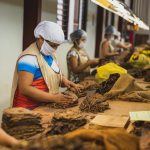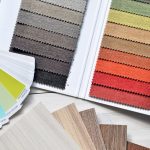Polypropylene fabrics are made from a strong, lightweight thermoplastic polymer that repels moisture and dries quickly. You’ll find them in activewear, sportswear, upholstery, home textiles, industrial gear, and medical products like masks and gowns. Their durability, resistance to stains, and chemical resilience make them perfect for everything from workout clothes to heavy-duty covers. If you want to understand why they’re so versatile and how they impact the environment, there’s plenty more to explore.
Table of Contents
Key Takeaways
- Polypropylene fabrics include nonwoven, woven, spunbond, meltblown, and knit types, each suited for specific applications and performance needs.
- Common products made from polypropylene fabrics are activewear, upholstery, industrial bags, medical gowns, masks, and disposable hygiene items.
- Polypropylene fabric’s moisture resistance and quick-drying properties make it ideal for sportswear and outdoor clothing.
- Durable polypropylene fabrics are widely used in home textiles like rugs, curtains, and furniture upholstery due to stain and abrasion resistance.
- Industrial and medical sectors use polypropylene fabrics for protective gear, filtration, geotextiles, and disposable medical products.
Understanding Polypropylene Fabric Composition
Although polypropylene fabric might seem like just another synthetic material, understanding its composition reveals why it stands out in performance and versatility.
You’ll find that polypropylene is a thermoplastic polymer made from propylene monomers, created through a process called polymerization. This structure results in a lightweight, strong fiber with excellent resistance to moisture and chemicals.
When you wear or use polypropylene fabric, you’re benefiting from its ability to repel water and dry quickly, thanks to its hydrophobic nature. Unlike natural fibers, it doesn’t absorb much moisture, which helps keep you comfortable in various conditions.
Plus, polypropylene fibers have a low density, making the fabric feel lighter than many others. Knowing this composition helps you appreciate why polypropylene suits so many different applications.
Characteristics That Make Polypropylene Popular
Knowing how polypropylene’s composition influences its properties helps explain why this fabric has gained such widespread popularity.
You’ll appreciate its lightweight nature, which makes it easy to wear and handle without sacrificing strength. Polypropylene resists moisture and dries quickly, so it’s perfect for activewear or outdoor gear. You don’t have to worry about mildew or mold, as it naturally resists these issues.
Its chemical resistance means it stands up well to detergents and stains, keeping your clothes looking fresh longer. Plus, it’s highly durable, resisting abrasion and wear even with frequent use.
You’ll also find it’s cost-effective, offering great performance without a hefty price tag. These combined features make polypropylene a smart choice for many fabric applications.
Common Types of Polypropylene Fabrics
When you explore polypropylene fabrics, you’ll find several common types tailored for different uses.
These fabrics vary in texture, weave, and finish, designed to meet specific needs. Here are five popular types you might come across:
Polypropylene fabrics come in varied textures and weaves, each crafted to suit unique applications and requirements.
- Nonwoven polypropylene: Used in disposable products like masks and medical gowns.
- Woven polypropylene: Found in durable bags and upholstery.
- Spunbond polypropylene: Lightweight and breathable, ideal for protective clothing.
- Meltblown polypropylene: Features fine fibers, perfect for filtration applications.
- Polypropylene knit fabric: Offers stretch and comfort, commonly used in casual wear.
Each type leverages polypropylene’s unique properties, making it versatile across industries without sacrificing durability or performance.
You’ll notice these fabrics popping up in both everyday and specialized products.
Polypropylene in Activewear and Sportswear
When you wear activewear made from polypropylene, you benefit from its excellent moisture-wicking properties that keep you dry during workouts.
You’ll also appreciate its durability and flexibility, which let you move freely without worrying about wear and tear.
Plus, polypropylene fabrics are lightweight and breathable, making them perfect for sportswear that supports your performance.
Moisture-Wicking Properties
Because polypropylene fibers resist absorbing moisture, they excel at wicking sweat away from your skin during intense workouts. This keeps you dry and comfortable, preventing that sticky, clammy feeling most fabrics cause.
When you wear polypropylene activewear, sweat moves quickly from your body to the fabric’s surface, where it evaporates fast. This makes polypropylene ideal for activities where staying dry boosts performance and comfort.
Here’s why polypropylene’s moisture-wicking stands out:
- Dries faster than cotton or polyester
- Keeps skin cooler and drier
- Reduces chafing and irritation
- Maintains lightweight feel even when sweating
- Enhances comfort during long exercise sessions
With these benefits, polypropylene gear helps you stay focused and fresh.
Durability and Flexibility
Beyond keeping you dry, polypropylene also stands out for its durability and flexibility, making it a top choice for activewear and sportswear.
When you wear polypropylene-based gear, you benefit from fabric that resists wear and tear, even during intense workouts or outdoor activities. This material bends and stretches with your movements, so you won’t feel restricted or uncomfortable.
It holds up well against abrasion, meaning your clothes last longer despite repeated use and washing. Plus, polypropylene maintains its shape without sagging or losing elasticity, so your activewear stays supportive and snug.
If you’re looking for gear that can keep up with your lifestyle, polypropylene’s strength and adaptability make it an excellent fabric for everything from running tights to cycling jerseys.
Lightweight and Breathable
Although you mightn’t always notice it, the lightweight nature of polypropylene makes a huge difference in your comfort during physical activity. This fabric keeps you feeling light and unrestricted, allowing you to move freely without extra weight dragging you down.
Its breathability helps wick moisture away, keeping sweat off your skin and preventing overheating. When you choose activewear made from polypropylene, you get gear that supports your performance by managing heat and moisture effectively.
Here’s why polypropylene stands out in sportswear:
- Feels barely there, enhancing agility
- Dries quickly after sweating
- Prevents chafing with smooth texture
- Maintains breathability during intense workouts
- Resists odors by keeping you dry
With polypropylene, your workout wear works as hard as you do.
Use of Polypropylene in Upholstery and Home Textiles
You’ll find polypropylene’s durability makes it a smart choice for upholstery that stands up to daily wear.
Its stain resistance keeps your furniture looking fresh, even with spills.
Plus, it’s commonly used in rugs, curtains, and other home textiles that need both strength and easy care.
Durability in Upholstery Fabrics
How does polypropylene stand up to the demands of upholstery fabrics? When you choose polypropylene, you’re opting for impressive durability that handles everyday wear and tear with ease.
This fabric resists stretching and sagging, so your furniture keeps its shape over time. It also holds up well against friction, making it perfect for high-traffic areas.
Here’s why polypropylene excels in upholstery durability:
- Resistant to abrasion and pilling
- Maintains structural integrity under heavy use
- Stretches minimally, preserving fit and form
- Withstands exposure to moisture without weakening
- Retains color and texture after prolonged use
Stain Resistance Properties
Polypropylene fabrics offer exceptional stain resistance, making them a smart choice for upholstery and home textiles.
When you use polypropylene, spills and dirt don’t easily penetrate the material, so stains wipe away quickly. This fabric’s low moisture absorption means liquids sit on the surface instead of soaking in, giving you more time to clean up messes before they set. You won’t have to worry about stubborn stains ruining your furniture or décor.
Plus, polypropylene’s resistance to oils, chemicals, and mildew keeps your textiles looking fresh longer. If you want easy-to-maintain, stain-resistant upholstery or home fabrics, polypropylene stands out as a practical and effective option.
It helps you keep your living spaces clean without extra hassle.
Common Home Textile Uses
When choosing fabrics for upholstery and home textiles, durability and ease of care often top the list.
Polypropylene fits the bill perfectly, offering resistance to stains, moisture, and wear. You’ll find it commonly used in various home settings because it holds up well under daily use and cleaning.
Its affordability and color retention also make it a practical choice for many households.
Here are some popular polypropylene textile uses around your home:
- Upholstery for sofas and chairs
- Outdoor cushions and patio furniture covers
- Area rugs and carpets
- Curtains and drapes
- Mattress covers and bedspreads
Industrial Applications of Polypropylene Fabrics
Since you often need durable and lightweight materials in demanding environments, polypropylene fabrics fit the bill perfectly.
Durable and lightweight, polypropylene fabrics are ideal for challenging industrial environments.
You’ll find them in industrial settings where resistance to chemicals, moisture, and abrasion is essential. For example, polypropylene fabrics are widely used in geotextiles to stabilize soil and prevent erosion.
You can also rely on them for making protective covers, tarps, and industrial bags that handle heavy loads without tearing. Their resistance to mildew and UV rays means they hold up outdoors, making them ideal for agricultural and construction applications.
When you need materials that combine strength with flexibility, polypropylene fabrics deliver consistent performance, helping you tackle tough tasks efficiently and cost-effectively in your industrial operations.
Polypropylene in Medical and Hygiene Products
Although medical and hygiene products demand strict standards, you’ll find polypropylene fabrics meet those needs with ease.
Their lightweight, breathable, and moisture-wicking properties make them ideal for maintaining comfort and cleanliness. Plus, polypropylene is resistant to bacteria and chemicals, ensuring hygiene and safety in sensitive environments.
You’ll often see polypropylene used in:
- Surgical gowns and drapes
- Face masks and respirators
- Disposable diapers and sanitary pads
- Medical packaging and wraps
- Wound care dressings
These applications benefit from polypropylene’s durability and ability to act as a barrier against contaminants.
When you choose products made from polypropylene, you’re trusting a fabric that supports stringent medical safety requirements while keeping user comfort top priority.
Environmental Impact and Sustainability of Polypropylene Fabrics
Because polypropylene fabrics are widely used across industries, understanding their environmental impact matters to you as a consumer or manufacturer.
Polypropylene is lightweight and durable, which reduces transportation emissions and extends product life. However, it’s derived from non-renewable fossil fuels and isn’t biodegradable, contributing to long-term pollution if improperly disposed of.
You can mitigate this by choosing recycled polypropylene fabrics, which lower resource consumption and waste. Also, many companies now offer take-back programs and promote recycling to enhance sustainability.
When you prioritize products made with recycled or responsibly sourced polypropylene, you support reducing environmental harm. Staying informed helps you make smarter decisions that balance polypropylene’s benefits with ecological responsibility.
Frequently Asked Questions
How Is Polypropylene Fabric Manufactured Step-By-Step?
You start by melting polypropylene pellets, then extrude the molten polymer into fibers. Next, you cool and stretch these fibers, spin them into yarn, and finally weave or knit the yarn into fabric, ready for use.
Can Polypropylene Fabric Be Dyed With Natural Dyes?
You can’t easily dye polypropylene fabric with natural dyes because it’s hydrophobic and resists absorbing water-based colors. You’ll need special dyeing methods or synthetic dyes to get vibrant, lasting colors on polypropylene fabrics.
What Are the Care Instructions for Washing Polypropylene Fabrics?
When your polypropylene fabric takes a swim, treat it gently: wash in cool water, skip harsh detergents, and avoid high heat. You’ll keep it fresh and vibrant, like a calm breeze on a sunny day.
How Does Polypropylene Fabric Compare to Polyester in Cost?
You’ll find polypropylene fabric generally costs less than polyester because it’s cheaper to produce. However, polyester offers more durability and versatility, so your choice depends on your budget and how you plan to use the fabric.
Are There Any Allergies Associated With Polypropylene Fabric?
You might worry about allergies with polypropylene fabric, but it’s actually hypoallergenic and rarely causes reactions. You can comfortably wear or use it without fearing skin irritation or allergic responses, making it a safe choice.
- Does Chiffon Fabric Stink - July 15, 2025
- Does Chiffon Fabric Affect the Economy - July 15, 2025
- Does Cotton Fabric Have a Nap - July 15, 2025







